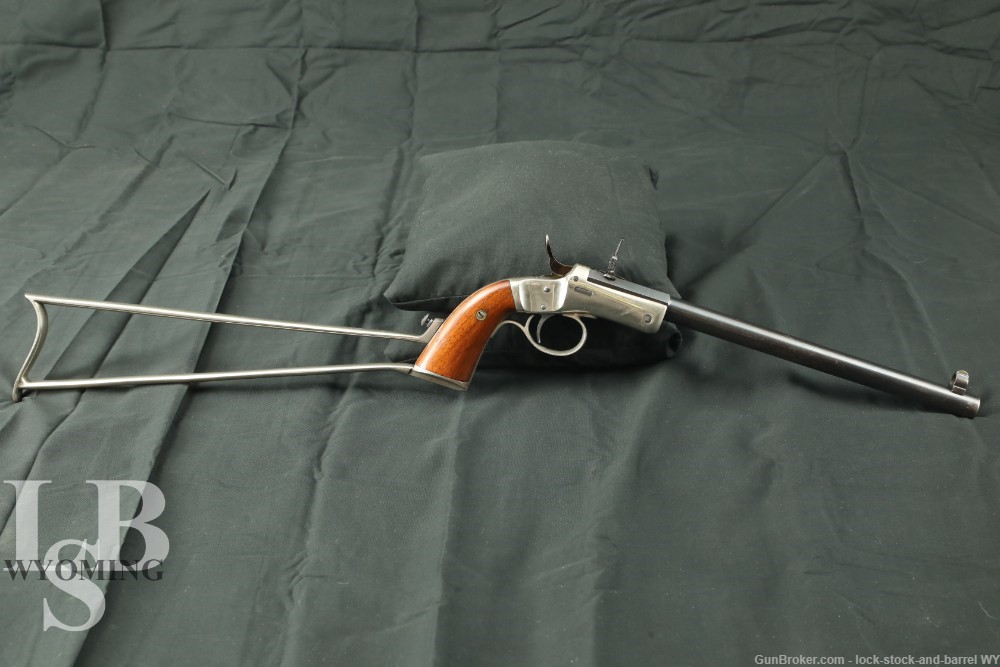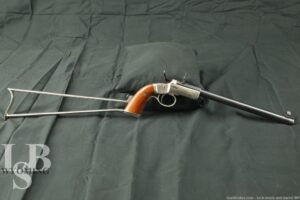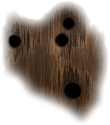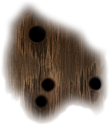
J. Stevens “Tip- Up” Model 40 .22cal. 10 inch barrel ca.1890s
SOLD FOR: $815
WOA#: WY240318RU025
Make: J. Stevens
Model: 40
Serial Number: 88764
Year of Manufacture: 1890s Antique
Caliber: 22
Action Type: Single shot
Markings: Top flat of the octagon /round heavy barrel shows “J. STEVENS A &T CO. Chicopee Falls Mass USA” in TWO LINES; Some of which is covered by the rear sight; the Serial number “88764”on the left flat of the chamber. Underneath the brass framed pummel we see the matching serial number “88764”
Barrel Length: 9 ? inches
Sights / Optics: The front sight is finely preserved by the hood that still protects the thin post with beaded top. On top the hood there is a brass half oval blade. The rear sight is replaced, evident by its placement over the marking but is proper to the J. Stevens “Tip up” Platform. Its adjustable v notch is for fast acquisition with the half oval brass blade previously mentioned and the peep sight for more fine shooting. The rear sight is authentic to J. Stevens but in this writer’s opinion not original to this weapon.
Stock Configuration & Condition: The grips (9 out of 10) are oranged walnut and are smooth and shiny with original oil finish, showing good grain. With only a few compression marks from handling. There is a lot of luster in the grain. The brass escutcheons are original to the set and show the proper amount of wear for a 125 year old item. The grips rate in about 9/10 overall condition. The detached wire stock is marked with the same serial number “88764” and is made of steel. This item does seem to be original to the item. Its profile and shape and serif numbering style exactly match the cataloged versions. In my opinion enthusiasts would be enthused to see this.
Magazine Quantity & Condition: No Magazine only a single shot may be fired
Type of Finish: Blued steel and Nickel Coated steel Frame with walnut grips.
Finish Originality: Finish is original and has not been redone.
Bore Condition: The bore is smooth and shows minimal pitting (9 out of 10) and the rifling is worn but still viable.(8 out of 10) There is very minimal erosion in the bore.
Overall Condition: This handgun retains about 85% of its metal finish. I noticed a repair on the hammer spur where it seems to have been cracked. The repair was done expertly and its function has not been interfered with. The screw heads are smooth and crisp, letting me know that only skilled smiths were allowed to work on this item and show little access to the pistol over the last century. The lock up has very little play. The markings are strong. Overall, this handgun rates in about 85% condition. In this writer’s opinion this piece rates in Very Good condition.
Mechanics: The action functions correctly.. We did not fire this handgun. As with all used firearms, a thorough cleaning may be necessary to meet your maintenance requirements.
Box, Paperwork & Accessories: Steel “Shoulder stabilizer” Stock
Our Assessment: Joshua Stevens was born on September 10, 1814 in Chelsea or Chester, Mass.—there is a dispute over his birth place. For 26 years, Stevens worked for other New England gun makers including Samuel Colt, Eli Whitney, Cyrus Allen, Edwin Wesson, and the Mass. Arms Co. In 1864, Joshua Stevens started his factory at the age of 50 with 2 partners, James Taylor and W. B. Fay. He died in 1907, at the age of 92 having been retired from Stevens for 10 years. Joshua Stevens was not an inventor, but just a good businessman. In 1864, he obtained patent # 44123 for a very basic, breech-loading tip-up that became the basis for all but two of the 14 Stevens single-shot pistols. Joshua Stevens left the firm with a substantial fortune at the age of 82. In 1864, Joshua Stevens started his factory in Chicopee Falls, Mass. on the north side of the Chicopee River. It was located in an old grist mill and the company’s name was “J. Stevens & Co.” The factory started when the Civil War was close to an end. The company was a world leader in the arms market until the early 1900s. Many established gun manufacturers failed after the Civil War due to the market surplus of guns.
In this writer’s opinion the “tip up” has some of the sleekest styling and most elegant grips of their time. These guns are fun to shoot and are sure to be a prize in any collection. It was a treat to see this heavy barrel model 40 tip up. I own a few. Really love that these guns were mainly made for “enjoyment and entertainment” as opposed to the other rifles made throughout the civil war. These guns were known as “ PARLOR PISTOLS” because people would literally shoot them in the parlor. Back then, when guests arrived, the house host would have been obliged to entertain them. So they might find a deck of cards, place a few in the fireplace, serve some brandy and cigars, while playing “HORSE” with their extremely accurate target pistols in the parlor. Enjoy owning this antique arm.
Kris F.



